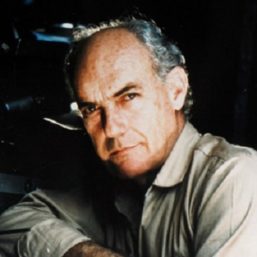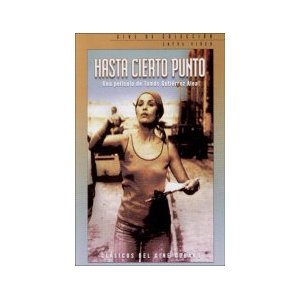Tomás Gutiérrez Alea was born on December 11, 1928 was a Cuban film director. He wrote and directed more than 20 feature films, documentaries and short films, which are known for their acute vision in post-revolutionary Cuba, and have a delicate balance between dedication to revolution and criticism of the social, economic and political conditions of the country.
Born in Havana, Gutiérrez was raised in a well-off, politically progressive family. Alea was sent to the university in Havana to follow in his father’s footsteps and become a lawyer. Almost at the same time he entered the school, however, he acquired an 8 mm and made two short films, El fakir (1947) and La Caperucita Roja (1947). Several years later, he collaborated with the other students (and great future film) ‘Néstor Almendros’ in a short adaptation of Kafka that they called ‘Everyday Confusion’ (1950). After graduation, Alea traveled to Italy to study film direction for two years on the crest of neorealism at the famous Centro Sperimentale de Cinematografía. He was strongly influenced by Italian neo-realism, and created his first films in Rome with the future Cuban colleague Julio García Espinosa, with whom he co-directed the documentary El Mégano (The Coal Worker). He returned to Cuba in 1953 and joined the radical “Nuestro Tiempo”, the cultural society, to actively work in the film section, working as a publicist and aligning with Castro’s struggle against Batista regime in 1953.
Shortly after the success of the Cuban Revolution led by Fidel Castro in 1959, Gutiérrez, Espinosa, and several other young filmmakers founded the Cuban Institute of Art and Cinematographic Industry (ICAIC). As fervent defenders of the Revolution, the ICAIC was a collective of a filmmaker who believes the film is the most important form of modern art and the best means to distribute the revolutionary thought of the masses. This Gutiérrez Tierra Nuestra (our land), was the first documentary made after the revolutionary triumph. ICAIC focused mainly on documentaries and newreels in its formative years, but over time it expanded to the production of feature films, among them the first Gutiérrez Historias de la Revolución (Stories of the Revolution) (1960), the first fiction film of the ICAIC, and Twelve Chairs (twelve chairs), (1962).
First Gutierrez highly successful feature, Death of a Bureaucrat (Death of a Bureaucrat) (1966) is presented as a kind of tribute to the history of film comedy, and includes direct allusions to the work of Buster Keaton, Laurel & Hardy, of Luis Buñuel, and many others. The story follows a young man’s confusing situation through bureaucratic offices so that his uncle died exhumed and buried again then after the body is buried with his ID card.
His next film, Memories of Underdevelopment (Memoirs of Underdevelopment) (1968) was the first Cuban film shown in the United States since the Revolution. Based on the novel by Edmundo Desnoes “Inconsolable Memories”, the film is the memory of a morally ambiguous bourgeois intellectual life in Havana in the period between the invasion of the Bay of Pigs and the Cuban Missile Crisis. The protagonist is not willing to adopt a political stance in one way or another, however, continues to despise the country around him to be upside down and underdeveloped. His life, finally, vanishes into nothingness, becoming a personality that has no use in this new Cuba.
Although the criticism of the Cuban Revolution and society was at the heart of not only the memories, but all Gutiérrez’s works, Gutiérrez continued to be an avid supporter of Cuban socialism. But his works could not be described as propaganda either. Gutiérrez describes the motivation for his contradictory approach saying: “… the cinema provides an active and mobilizing element that stimulates participation in the revolutionary process.” So, it is not enough to have a moralizing cinema based on harangue and exhortation. We need a cinema that promotes and develops a critical attitude, but how can we criticize and at the same time strengthen the reality in which we are immersed? ”
In the following decades, Gutiérrez divided his time between making his own films and mentoring promising young filmmakers through the ICAIC.
In 1972 and 1976, respectively, Gutiérrez made two historical feature films, A Cuban Fight Against the Demons (A Cuban Fight Against the Demons) and The Last Supper (The Last Supper). Both the series in Spanish colonial Cuba, the contradictions and the hypocrisy of studying the films in Cuba’s past of imperialism, religion, and slavery.
‘Hasta True Punto’ a film with ex-wife, Mirta Ibarra, although she suffered censorship until today, is considered by Cuban critics to be one of her minor works. The director himself joked that the film is successful only “to a certain extent.” Alea returned once again the nexus between the sexual and the political with the best known film of Cuba of the 90s, “Strawberry and chocolate,” (1993) _. The history of the uncommon friendship that develops between a naive believer in Castro’s contemporary version of communism and the greater experience and critical of homosexuals of the regime was highly praised and harshly criticized. Some found it untypically mild for Alea and read his gay leadership as a cover-up for Castro’s horrific treatment of homosexuals, while others thought that unnecessarily provocative in their characterizations, such divergent responses only attest to the complexity typical of Alea tapestries. In 1994, Strawberry and Chocolate became the first Cuban film to receive an Oscar nomination for Best Foreign Film.
In the 1990s, Gutiérrez fell into poor health, forcing him to co-direct his last two films with his friend Juan Carlos Tabío. Gutiérrez’s Final Film, Guantanamera, (1994) uses traditional elements, such as a choral cast and romantic comedy to adopt a more subtle approach to the goals of the old Gutiérrez: underdevelopment and bureaucracy. The film won the SilveJury Prize at the 44th International Film Festival in Berlin.
Titón, as he was known to his friends, died at age 68 on April 16, 1996. He is buried in the Cemetery of Colón, Havana.
“TITON” GUTIÉRREZ ALEA, DESTACADO CINEASTA CUBANO.
Tomás Gutiérrez Alea nacio un 11 diciembre 1928 fue un director de cine cubano. Escribió y dirigió más de 20 largometrajes, documentales y cortometrajes, que son conocidos por su visión aguda en la post-Cuba revolucionaria, y poseen un delicado equilibrio entre la dedicación a la revolución y la crítica de las condiciones sociales, económicas y políticas de el país.
https://youtu.be/nv0KuZKEc5M
Nacido en La Habana Gutiérrez fue criado en una familia acomodada, políticamente progresista. Alea fue enviado a la universidad en La Habana para seguir los pasos de su padre y convertirse en un abogado. Casi al mismo tiempo entró en la escuela, sin embargo, adquirió un 8 mm y realizó dos cortometrajes, El faquir (1947) y La Caperucita Roja (1947). Varios años más tarde, colaboró con los otros estudiantes (y gran película futuro) ‘Néstor Almendros’ en un corto de adaptación de Kafka que llamaron Una confusión cotidiana ‘(1950). Después de su graduación, viajó Alea a Italia para estudiar dirección de cine durante dos años en la cresta del neorrealismo en el famoso Centro Sperimentale de Cinematografía. Él fue fuertemente influenciado por el neorrealismo italiano, y creó sus primeras películas en Roma con el futuro colega cubano Julio García Espinosa, con quien co-dirigió el documental El Mégano (El Trabajador de carbón). Regresó a Cuba en 1953 y se unió a la radical “Nuestro Tiempo”, la sociedad cultural, a trabajar activamente en la sección de cine, trabajando como publicista y alineándose con la lucha de Castro contra Batista regime.in del 1953.
Poco después del éxito de la Revolución Cubana liderada por Fidel Castro en 1959, Gutiérrez, Espinosa, y varios otros jóvenes cineastas fundó el Instituto Cubano del Arte y la Industria Cinematográphicos (ICAIC). Como fervientes defensores de la Revolución, el ICAIC era colectiva de un cineasta que se cree la película que es la forma de arte moderno más importante y el mejor medio para distribuir el pensamiento revolucionario de las masas. This Gutiérrez Tierra Nuestra (nuestra tierra), fue el primer documental realizado después del triunfo revolucionario. ICAIC se centró principalmente en documentales y newreels en sus años de formación, pero con el tiempo se expandió a la producción de largometrajes, entre ellos los primeros Gutiérrez Historias de la Revolución (Historias de la Revolución) (1960), primera película de ficción del ICAIC, y Doce Sillas (doce sillas) , (1962).
Primera Gutiérrez función de gran éxito, Muerte de un burócrata (muerte de un burócrata) (1966) se presenta como una especie de homenaje a la historia de la comedia cinematográfica, e incluye alusiones directas a la obra de Buster Keaton, Laurel & Hardy, de Luis Buñuel , y muchos otros. La historia sigue difícil situación de confusión de un joven a través de oficinas burocráticas para que su tío muerto exhumados y enterrados de nuevo a continuación, después de que el cuerpo es enterrado con su tarjeta de identificación.
Su siguiente película, Memorias del Subdesarrollo (Memorias del subdesarrollo) (1968) fue la primera película cubana que se muestra en los Estados Unidos desde la Revolución. Basado en la novela de Edmundo Desnoes “Inconsolable Memories”, la película es la memoria de una vida moralmente ambiguo intelectual burgués en La Habana en el período entre la invasión de Bahía de Cochinos y la Crisis de los Misiles de Cuba. El protagonista no está dispuesto a adoptar una postura política de una manera u otra, sin embargo, continúa a despreciar el país en torno a él por ser al revés y subdesarrollado. Su vida, finalmente, se desvanece en la nada, convirtiéndose en una personalidad que no tiene ningún uso en esta nueva Cuba.
Aunque la crítica de la Revolución y la sociedad cubana estaba en el corazón de no sólo los recuerdos, pero todas las obras de Gutiérrez, Gutiérrez continuó siendo un ávido partidario del socialismo cubano. Pero sus obras no podría ser descrito como la propaganda tampoco. Gutiérrez describe la motivación por su enfoque contradictoria diciendo: “… el cine proporciona un elemento activo y movilizador, que estimula la participación en el proceso revolucionario. Entonces, no es suficiente para tener un cine moralizante basado en la arenga y la exhortación. Necesitamos un cine que promueve y desarrolla una actitud crítica. Pero, ¿cómo criticar y al mismo tiempo, fortalecer la realidad en la que estamos inmersos? ”
En las décadas siguientes, Gutiérrez dividió su tiempo entre la fabricación de sus propias películas y tutoría prometedores jóvenes cineastas a través del ICAIC.
En 1972 y 1976, respectivamente, Gutiérrez realizó dos largometrajes históricos, Una Pelea Cubana Contra Los Demonios (Una pelea cubana contra los demonios) y La última cena (The Last Supper). Tanto la serie en español la Cuba colonial, las contradicciones y la hipocresía de estudio las películas en el pasado de Cuba del imperialismo, la religión, y la esclavitud.
‘Hasta Cierto Punto’ un film con ex esposa, Mirta Ibarra aunque sufrió la censura hasta hoy es considerada por la crítica cubana una de sus obras menores. El propio director dijo en broma que la película tiene éxito sólo “hasta cierto punto.” Alea regresó una vez más el nexo entre lo sexual y lo político con la película más conocida de Cuba de la década del 90, “Fresa y chocolate,” (1993) _. La historia de la amistad poco común que se desarrolla entre un creyente ingenuo en versión contemporánea de Castro del comunismo y la mayor experiencia y crítico de homosexuales del régimen fue muy elogiado y tan duramente criticado. A algunos les resultó atípicamente suave para Alea y leer su liderazgo gay como un encubrimiento de tratamiento horrible de Castro de los homosexuales, mientras que otros pensaban que innecesariamente provocador en sus caracterizaciones, tales respuestas divergentes sólo dan testimonio de la complejidad típica de tapices Alea. En 1994, Fresa y chocolate se convirtió en la primera película cubana en recibir una nominación al Oscar como Mejor Película Extranjera.
En la década de 1990, Gutiérrez cayó en la mala salud, lo que le obligó a co-dirigir sus últimas dos películas con su amigo Juan Carlos Tabío. La pelicula Final de Gutiérrez, Guantanamera, (1994) utiliza elementos tradicionales, como un reparto coral y la comedia romántica de adoptar un enfoque más sutil a los objetivos de los viejos Gutiérrez: el subdesarrollo y la burocracia. La película ganó el Premio SilveJury en el 44o Festival de Cine Internacional de Berlín.
Titón, como se le conocía a sus amigos, murió a los 68 años el 16 de abril de 1996. Está enterrado en el Cementerio de Colón, La Habana.
Agencies/Wiki/CubanMov./Internet Photos/ You Tube/ Arnoldo Varona/ TheCubanHistory.com
THE CUBAN HISTORY, HOLLYWOOD.









